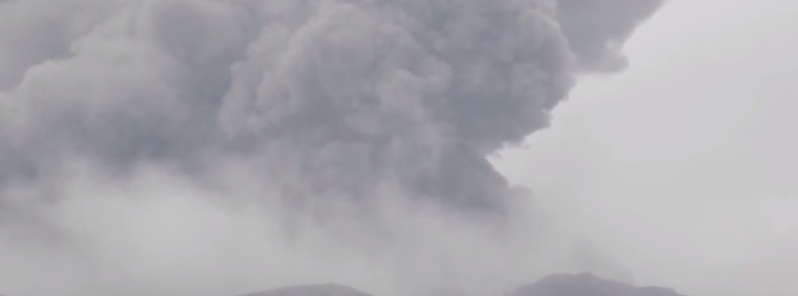Asosan – the largest volcano in Japan enters new eruptive phase, Kyushu

Asosan, the largest active volcano in Japan and one of the world's largest volcanoes, started its new eruptive phase this week prompting Japanese authorities to cancel or divert flights on Thursday, November 27, 2014.
A column of ash and smoke reached about 2 133 meters at 06:00 UTC today and was extending north, according to latest Tokyo VAAC warning. An exclusion zone of 1 km radius around the volcano is in place.
Activity from the Asosan's Nakadake crater has intensified on Tuesday, November 25 when observed ash emissions and comparably strong incandescence suggested a new magmatic eruption could be under way.
The height of the emitted ash plumes was up to 8 000 ft (2.4 km) on Wednesday and light ash fall was reported from Namino village 11 km NE of the Nakadake cone, VolcanoDiscovery reported and added that the volcano had been showing signs of unrest since 2013, with intermittent small, probably phreatic explosions and weak to moderate glow sometimes visible from the crater.
During 2013, the crater lake gradually disappeared, probably as a result of increasing temperatures leading to its evaporation. The Japan Meteorological Agency (JMA) placed it on Alert Level 2 (Do not approach the crater) on August 30 this year.
Last month, experts warned a disaster on Kyushu island, which has been struck by seven massive eruptions over the past 120 000 years, could see an area that is home to seven million people buried by molten rock in just two hours. (CNA)
JMA mentioned in its latest monthly bulletin that the edifice of Nakadake showed slight inflation, which could support the hypothesis of intruding magma. (VD)

Meteorologists warned volcanic stones and ash could fall in a one-kilometer radius of the volcano.
This eruption comes two months after Ontakesan in central Nagano killed more than 60 hikers when it erupted without warning.
Geologic summary
The 24-km-wide Asosan caldera was formed during four major explosive eruptions from 300,000 to 90,000 years ago. These produced voluminous pyroclastic flows that covered much of Kyushu. The last of these, the Aso-4 eruption, produced more than 600 cu km of airfall tephra and pyroclastic-flow deposits. A group of 17 central cones was constructed in the middle of the caldera, one of which, Nakadake, is one of Japan's most active volcanoes. It was the location of Japan's first documented historical eruption in 553 AD. The Nakadake complex has remained active throughout the Holocene.


360° panoramic view of Suna-Senri-ga-Hama and crater near Nakadake peak. Author: Nudimmud
Several other cones have been active during the Holocene, including the Kometsuka scoria cone as recently as about 210 CE. Historical eruptions have largely consisted of basaltic to basaltic-andesite ash emission with periodic strombolian and phreatomagmatic activity. The summit crater of Nakadake is accessible by toll road and cable car, and is one of Kyushu's most popular tourist destinations. (GVP)
Featured image: Asosan eruption on November 25, 2014. Image credit: screenshot from FNNnewsCH video.

Commenting rules and guidelines
We value the thoughts and opinions of our readers and welcome healthy discussions on our website. In order to maintain a respectful and positive community, we ask that all commenters follow these rules:
We reserve the right to remove any comments that violate these rules. By commenting on our website, you agree to abide by these guidelines. Thank you for helping to create a positive and welcoming environment for all.